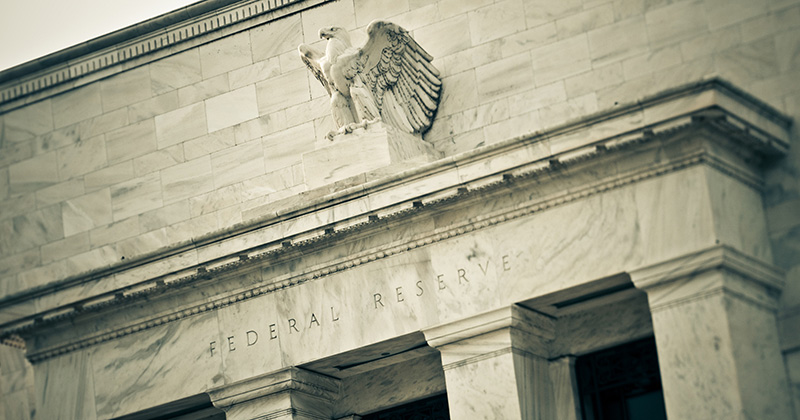


Federal Reserve Analysis
Photo by Getty December 14, 2018
Fed’s November meeting minutes reveal a strong economy and a likely interest rate increase
Editor’s note: James Butkiewicz, professor of economics at the University of Delaware's Alfred Lerner College of Business and Economics, provides an in-depth analysis of the Federal Reserve’s November meeting minutes.
Sources of strength contributing to economic growth discussed at the November meeting of the Federal Reserve’s Open Market Committee (FOMC) include strong consumer spending, federal defense spending and state and local government construction spending. Weaknesses including slowing residential construction, weaker business investment and decreasing net exports due to a stronger dollar, all of which are likely due to rising interest rates in the U.S.
Labor market strength was evidenced by strong job growth, a historically low rate of unemployment, and increased labor force participation, meaning a return to the job market by individuals who had previously withdrawn. Reports of labor market strength were accompanied by reports of labor shortages, especially for skilled workers, and upward pressure on wages that could increase inflation.
Inflation Measurements
Inflation measured by the personal consumption price index (PCE) was at the Fed’s inflation target of a 2% annual increase, while the consumer price index (CPI) increased by 2.3% during the September 2017 to September 2018 period. Historically, the CPI increases 0.5% percent faster than the PCE, meaning a target inflation rate of 2% measured by the PCE will average about 2.5% measured by the CPI. Survey data indicates expectations of future inflation are stable.
Notable uncertainties included the sustainability of corporate earnings, the diminishing impact of the tax cut, and uncertainties due to trade policy. Also concerning were indications of slower growth in the euro-area, China and Japan.
Fed Interest Rates
The committee voted to maintain its federal funds interest rate target of between 2 and 2.25% in November, but agreed that a 0.25% increase in its target range is likely at its next meeting, Dec. 18-19. It also voted to continue to reduce its holdings of Treasury securities by $30 billion each month and its holdings of agency debt and agency mortgage-backed securities by $20 billion each month.
A notable change discussed at the November meeting was that the FOMC will focus more on incoming data next year to inform its policy decisions, likely revising its statement that there would be “further gradual increases” in its interest rate targets. The committee emphasizes that this policy approach will be more flexible responding to changes in the economy. This change makes the projected three to four rate increases in 2019 less certain.
On Nov. 28, Fed Chairman Jerome Powell told the Economic Club of New York that interest rates are close to the “neutral rate of interest,” sparking stock market rally. Previously, on Oct. 3, he said that rates were far below neutral. The markets began a 10% correction the next day.
The neutral rate of interest is the rate consistent with steady growth and stable unemployment and inflation. The neutral rate combines the real (before inflation) cost of short-term borrowing and the long-run expected rate of inflation. The Fed’s 2% inflation target should define the long-run expected rate of inflation. Before the financial crisis, it was general believed that equilibrium real short-term interest rate was 2%, making the neutral rate 4%. It is now believed that since the crisis the equilibrium real rate has decreased to about 1%. With an inflation target of 2%, the new neutral rate is 3%, but no one is certain.
If the Fed keeps its target rate below the neutral rate, growth will accelerate and inflation will increase. If the Fed keeps its policy rate too high, growth will slow unnecessarily, possibly resulting in a recession. The only way to determine the neutral rate is to find that rate at which growth follows its potential path, and unemployment and inflation are stable. Only through experience can the value of the neutral rate be approximately determined.
Another concern is the outlook for inflation. The Fed’s policy actions begin to affect economic growth and unemployment after a one-year lag. Its impact on inflation begins after a two-year lag. Thus, the very strong labor market today could mean increased inflation next year. Higher tariffs will also cause a temporary increase in inflation, but will not change the long-run trend rate of inflation.
So even if the Fed’s policy rate is near neutral now, if inflation accelerates next year, expect the Fed to continue to increase interest rates.
2019 Economic Forecast
The 2019 Economic Forecast, scheduled for Feb. 19 and hosted by the Lyons Companies and the Lerner College Center for Economic Education and Entrepreneurship, will will bring together distinguished voices that influence, determine and interpret U.S. economic policy to discuss the upcoming year’s economic climate further. The goal is to provide the local Delaware financial community with a better understanding of how the upcoming year's economic climate will affect local business.
Registration is now open for this event which will be moderated by Jon Hilsenrath, chief economics correspondent for The Wall Street Journal. It will feature Loretta J. Mester, president and chief executive officer of the Federal Reserve Bank of Cleveland, Michael K. Farr, author, CNBC contributor and president of investment advisory firm Farr, Miller & Washington, LLC and Joan K. Woodard, president of the Travelers Institute and EVP, Public Policy, Travelers Companies, Inc. as speakers. In addition, annually at this event, a member of the community is awarded the James B. O'Neill Award in Economic Education & Entrepreneurship; this award will be presented to its sixth recipient this year — Discover Bank's Amy Walls for her ongoing support of CEEE programming.
Contact Us
Have a UDaily story idea?
Contact us at ocm@udel.edu
Members of the press
Contact us at 302-831-NEWS or visit the Media Relations website

